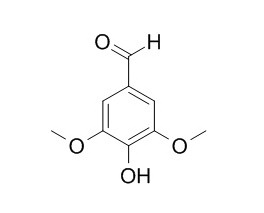Syringaldehyde
4-Hydroxy-3,5-dimethoxybenzaldehyde is an organic compound that occurs naturally in trace amounts, it possesses powerful antioxidant activity, in minimizing DNA damage, and activating survival signal Akt pathway, and it may be of value in the development of radioprotective compounds. It is used in pharmaceuticals, food, cosmetics, textiles, pulp and paper industries, and even in biological control applications.
Inquire / Order:
manager@chemfaces.com
Technical Inquiries:
service@chemfaces.com
Tel:
+86-27-84237783
Fax:
+86-27-84254680
Address:
1 Building, No. 83, CheCheng Rd., Wuhan Economic and Technological Development Zone, Wuhan, Hubei 430056, PRC
Providing storage is as stated on the product vial and the vial is kept tightly sealed, the product can be stored for up to
24 months(2-8C).
Wherever possible, you should prepare and use solutions on the same day. However, if you need to make up stock solutions in advance, we recommend that you store the solution as aliquots in tightly sealed vials at -20C. Generally, these will be useable for up to two weeks. Before use, and prior to opening the vial we recommend that you allow your product to equilibrate to room temperature for at least 1 hour.
Need more advice on solubility, usage and handling? Please email to: service@chemfaces.com
The packaging of the product may have turned upside down during transportation, resulting in the natural compounds adhering to the neck or cap of the vial. take the vial out of its packaging and gently shake to let the compounds fall to the bottom of the vial. for liquid products, centrifuge at 200-500 RPM to gather the liquid at the bottom of the vial. try to avoid loss or contamination during handling.
ACS Pharmacol. Transl. Sci.2023, 3c00129.
Toxicol Rep.2021, 8:1131-1142.
Molecules.2019, 24(10):E1930
Biochem Pharmacol.2020, 178:114083
Molecules.2019, 24(11):E2044
Cancer Manag Res.2019, 11:483-500
Front Plant Sci.2020, 10:1705
Research J. Pharm. and Tech.2020, 13(7):3059-3064.
National University of Pharmacy2022, 1:73-76
Journal of Oil Palm Research2019, 31(2):238-247
Related and Featured Products
Eur J Pharm Sci. 2008 Jan;33(1):52-9.
Radioprotection of 4-hydroxy-3,5-dimethoxybenzaldehyde (VND3207) in culture cells is associated with minimizing DNA damage and activating Akt.[Pubmed:
17981442]
Vanillin is a naturally occurring compound and food-flavoring agent with antioxidant and antimutagenic activities.
METHODS AND RESULTS:
In present study, we explored the radioprotective effect of a novel vanillin derivative VND3207 (4-Hydroxy-3,5-dimethoxybenzaldehyde). 4-Hydroxy-3,5-dimethoxybenzaldehyde has a much higher potential in scavenging hydroxyl radical and superoxide radical than vanillin as indicated in the ESR spin-trapping measurement, and it can effectively protect plasmid DNA against 10-50 Gy gamma-ray induced breaks in vitro at the concentrations as low as 10-20 microM. Using human lymphoblastoid AHH-1 cells and human fibroblastoid HFS cells, we demonstrated that 4-Hydroxy-3,5-dimethoxybenzaldehyde at 5-40 microM concentrations significantly attenuated the inhibition of proliferation and occurrence of apoptosis produced by 1-8 Gy gamma-irradiation. In the cultured cells, 4-Hydroxy-3,5-dimethoxybenzaldehyde significantly decreased the initial production and residual level of DNA double-strand breaks (DSBs) induced by 2 or 8 Gy irradiation. Treatment of 4-Hydroxy-3,5-dimethoxybenzaldehyde enhanced the level of DNA-PKcs protein, a critical component of DNA DSB repair pathway in the cells with or without gamma-irradiation. Consistently, the phosphorylation of Akt protein, a mediator of survival signal, as well as its substrate GSK3beta was concurrently increased by 4-Hydroxy-3,5-dimethoxybenzaldehyde.
CONCLUSIONS:
Our results suggest that 4-Hydroxy-3,5-dimethoxybenzaldehyde has radioprotection effect through its capabilities as a powerful antioxidant, in minimizing DNA damage, and activating survival signal Akt pathway, and it may be of value in the development of radioprotective compounds.
Spectrochim Acta A Mol Biomol Spectrosc. 2005 Oct;61(13-14):3087-96.
Effects of solvent, pH and beta-cyclodextrin on the photophysical properties of 4-hydroxy-3,5-dimethoxybenzaldehyde: intramolecular charge transfer associated with hydrogen bonding effect.[Pubmed:
16165057]
The photophysical properties of 4-hydroxy-3,5-dimethoxybenzaldehyde (HDMB) in various solvents, pH and in aqueous beta-cyclodextrin (CD) have been investigated. In non-polar solvents, 4-hydroxy-3,5-dimethoxybenzaldehyde gives only one emission maxima; whereas, in polar solvents it shows a dual luminescence. The increase in Stokes shift with increase in polarity is much more for longer wavelength (LW) than for a shorter wavelength (SW) band. This behaviour indicates the formation of an intramolecular charge transfer (ICT) state through relaxation from the normal excited state. Especially in water, the ICT emission is further red shifted to 430 nm with the normal emission band at 330 nm and the relative fluorescence intensities between 330 nm and 430 nm emission bands are affected by the excitation wavelength. However, this excitation wavelength dependence is not large in aqueous beta-CD solutions. These results suggest that the ICT state in polar solvents/water is stabilized through exciplex formation by the hydrogen-bonding interaction between the carbonyl group and polar solvents/water. The ground and excited state pK(a) values for the neutral-monoanion equilibrium have been measured and discussed. 4-hydroxy-3,5-dimethoxybenzaldehyde forms a 1:1 inclusion complex with beta-CD. A mechanism is proposed to explain the inclusion process.
J Fluoresc. 2014 May;24(3):695-707.
Spectral and molecular modeling studies on hydroxybenzaldehydes with native and modified cyclodextrins.[Pubmed:
24310479]
The inclusion complexation of 2-hydroxy-3-methoxybenzaldehyde (2HMB), 4-hydroxy-3-methoxybenzaldehyde (4HMB), 3,4-dimethoxybenzaldehyde (DMB) and 4-hydroxy-3,5-dimethoxybenzaldehyde (HDMB) with α-CD, β-CD, HP-α-CD and HP-β-CD were carried out by UV-Visible, steady-state and time-resolved fluorescence and PM3 methods. All the benzaldehydes shows dual fluorescence in aqueous and CD mediums and 1:1 inclusion complexes were formed with CDs. PM3 geometry optimizations results indicate that the 4-hydroxy-3,5-dimethoxybenzaldehyde /CD complex is significantly more favorable than the other complexes. The negative enthalpy changes suggest that the inclusion complexation processes are spontaneous. The geometry of the most stable complex shows that methoxy/OH group of HMBs is entrapped in the less polar CD cavities, while the aldehyde group present in the upper part of the CDs cavities.



